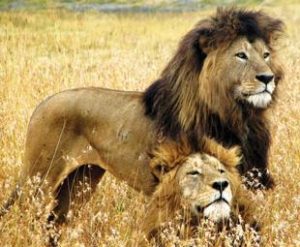13 Oct Are you a game ranger or zookeeper?
 Several years ago, I had the privilege to go on a safari to the Serengeti. It was such an amazing experience. One of the highlights was when we came across a pride of nine lions. The two males were lying in the short grass with their heads protruding. Nearby, the wildebeest walked past casually, but attentively. That was until the dominant male stood up. It was as though a shock wave went across the plain: everything scattered. There was electricity in the air; it was a sight to behold. The lion had such a commanding demeanour. I took so
Several years ago, I had the privilege to go on a safari to the Serengeti. It was such an amazing experience. One of the highlights was when we came across a pride of nine lions. The two males were lying in the short grass with their heads protruding. Nearby, the wildebeest walked past casually, but attentively. That was until the dominant male stood up. It was as though a shock wave went across the plain: everything scattered. There was electricity in the air; it was a sight to behold. The lion had such a commanding demeanour. I took so
many photos in a meagre attempt to try to capture the encounter.
I arrived back in South Africa and, for lack of a better word, was amped. In my enthusiasm, I decided to take my kids to the Johannesburg Zoo. As we edged our way closer to the big cats, our expectation grew. The Johannesburg Zoo has these large windowpanes allowing you to look right into the lion enclosure. It was our pure fortune to find a lion resting against the glass. In a rush of adrenaline, my kids bolted to touch the glass as if they were touching the lion itself. They were enthralled in the moment.
When I finally caught up and looked at this mighty beast, I was surprisingly disappointed. I started to question the reason for my unexpected feelings. They were so completely different to my recent experience. It dawned on me that there was a clear distinction between the two lions. The one had this majestic presence and radiated a bold authority. The other seemed so useless and pathetic.
Yet, when I examined the one in the zoo more carefully, I realised it had about the same size frame, same size paws, sharp teeth, and impressive mane. In fact, they were almost identical. In all aspects, they had the same potential. So why was there a difference?
My only conclusion was the difference in their environments. Now imagine the zookeeper coming to the captive lion and saying: “You are pitiable! You laze around here all day. You do not even smile for the visitors. You are so useless that I have to come and give you food. No more!” I do not know about you, but, if I were that lion, my response would be: “Jump in here and watch how I get my own food.” The whole scenario is absurd.
So, what has this got to do with safety? There are vast differences in the extent to which lions thrive in the wild and captivity – no matter how similar the beasts appear to be. It is the same with human beings. I frequently hear leaders complain about their employees’ unwillingness to take full responsibility for their work and safety. Recently, a senior manager voiced his irritation: “My people have such a bad attitude.” Fortunately, I knew him well enough to sarcastically reply: “Oh course they do, they work for you.” I wonder how many of the socalled “poor performers” are merely a reflection of their working environment? Is it possible that we are the primary reason for the very conditions we do not want?
I wonder how many managers would become annoyed and disengage if their suggestions or safety concerns were regularly ignored? When interacting with workers, I frequently come across this sentiment: “When I do a good job no one notices, but the day something goes wrong then my manager is quick to reprimand me. Why bother? No one cares anyway, unless I am in trouble.” If you worked in such a situation, wouldn’t you also become disgruntled and stop giving your best?
Tony Dovale said it best: “Even the best mindset will become contaminated and eventually blunted in a toxic organisational culture.” When there is a general lack of commitment concerning safety, or any issue in that matter; instead of blaming workers, it might be more apt for leaders to look in the mirror and ask what they have done to produce such an environment.
Just as lions thrive in a certain environment, so do human beings. Such an environment does not magically happen; it needs to be created. Effective leaders intentionally cultivate conditions that tap into individuals’ abilities; allowing them to grow and contribute their talents and creativity in order to achieve a meaningful purpose.
People are expected to take responsibility; so, their ideas should be listened to, concerns addressed, and recommendations supported. All employees should be empowered to do their work safely and should be held accountable for the decisions they make.
In your endeavour to have such a culture, how are you consciously functioning as a game ranger and staying clear of being a zoo keeper?
Dr Brett Solomon is the CEO of The Kinetic Leadership Institute and is a recognised leader in combining neuroscience, change management and leadership theory to drive cultural transformation processes. Brett specialises in neuroleadership, especially when it comes to an understanding of what motivates human behaviour and how to influence it. He has been involved in numerous culture change and leadership development initiatives throughout Africa, Australia, Canada, Saudi Arabia and the USA.

